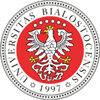Proszę używać tego identyfikatora do cytowań lub wstaw link do tej pozycji:
http://hdl.handle.net/11320/19016Pełny rekord metadanych
| Pole DC | Wartość | Język |
|---|---|---|
| dc.contributor.author | Wiśniewski, Piotr | - |
| dc.date.accessioned | 2025-10-13T07:57:00Z | - |
| dc.date.available | 2025-10-13T07:57:00Z | - |
| dc.date.issued | 2025 | - |
| dc.identifier.citation | Optimum. Economic Studies, Nr 3(121) 2025, s. 114-131 | pl |
| dc.identifier.issn | 1506-7637 | - |
| dc.identifier.uri | http://hdl.handle.net/11320/19016 | - |
| dc.description.abstract | Purpose | This study aims to determine the effect of ICTs utilisation on labour produc tivity. It compares how different aspects of the digital economy affect productivity in two groups of countries within the European Union – the developed (“the Old Europe”) and the developing (“the New Europe”). Research method | In this study, random forest regression was used on two groups of countries within the European Union. Results | The utilisation of ICTs between the two parts of the European Union is sig nificantly different. Two independent random forests show that the most influential variables in “the Old Europe” are the least influential in “the New Europe,” and vice versa. This showcases that the theory of the national ecosystem is correct. There is no universal way in which ICT adaptation influences productivity. Originality / value / implications / recommendations | This study reveals differences within the interconnected economy of the European Union. It shows that even in the case of widespread and accessible technologies, there are meaningful differences in their adaptation based on national ecosystems and regional factors. The findings should serve as a basis for future research on the institutional and regional factors influencing differences in ICT adaptation and utilisation. | pl |
| dc.language.iso | en | pl |
| dc.publisher | Wydawnictwo Uniwersytetu w Białymstoku | pl |
| dc.subject | digital economy | pl |
| dc.subject | productivity | pl |
| dc.subject | ICT | pl |
| dc.subject | digital divide | pl |
| dc.title | Exploring the Link between Icts Utilisation and Labour Productivity across the European Union | pl |
| dc.type | Article | pl |
| dc.rights.holder | © Copyright by Uniwersytet w Białymstoku | pl |
| dc.identifier.doi | 10.15290/oes.2025.03.121.06 | - |
| dc.description.Email | psw@umk.pl | pl |
| dc.description.Affiliation | Nicolaus Copernicus University in Toruń | pl |
| dc.description.references | Aissaoui N., 2022, The Digital Divide: a Literature Review and Some Directions for Future Research in Light of COVID-19, “Global Knowledge, Memory and Communication” vol. 71(8–9), pp. 686–708, DOI: 10.1108/GKMC-06-2020-0075. | pl |
| dc.description.references | Amador J., Silva C., 2025, The Impact of ICT Adoption on Productivity: Evidence from Portuguese Firm-level Data, “Empirica”, DOI: 10.1007/s10663-0025-09652-4. | pl |
| dc.description.references | Arbeláez-Rendón M., Giraldo D.P., Lotero L., 2023, Influence of Digital Divide in the Entrepreneurial Motor of a Digital Economy: a System Dynamics Approach, “Journal of Open Innovation: Technology, Market, and Complexity”, DOI: 10.1016/j.joitmc.2023.100046. | pl |
| dc.description.references | Baker N.B., Boustany M.S., Khater M., Haddad C., 2020, Measuring the Indirect Effect of the Internet on the Relationship between Human Capital and Labor Productivity, “International Review of Applied Economics”, pp. 821–838. DOI: 10.1080/02692171.2020.1792421. | pl |
| dc.description.references | Bauer J.M., 2018, The Internet and Income Inequality: Socio-economic Challenges in a Hyperconnected Society, “Telecommunications Policy”, pp. 333–343, DOI: 10.1016/j.tel‑pol.2017.05.009. | pl |
| dc.description.references | Byrne D., Corrado C., 2016, ICT Prices and ICT Services: What Do They Tell us about Productivity and Technology?, “Finance and Economics Discussion Series”, DOI: 10.17016/FEDS.2017.015r1. | pl |
| dc.description.references | Choudhary H., Bansal N., 2022, Addressing Digital Divide through Digital Literacy Training Programs: A Systematic Literature Review, “Digital Education Review”, pp. 224–248, DOI: 10.1344/der.2022.41.224-248. | pl |
| dc.description.references | Council for Science, Technology and Innovation, 2015, Society 5.0, https://www8.cao.go.jp/cstp/english/society5_0/index.html [date of access: 1.04.2025]. | pl |
| dc.description.references | Department of Industry, Science and Resources, 2021, Industry 4.0 Testlabs in Australia report, https://www.industry.gov.au/publications/industry-40-testlabs-australia-report [date of access: 2.04.2025]. | pl |
| dc.description.references | Duso T., Schiersch A., 2024, Let’s Switch to the Cloud: Cloud Usage and Its Effect on Labor Productivity, “Information Economics and Policy“, DOI: 10.1016/j.infoeco‑pol.2025.101130. | pl |
| dc.description.references | Dutton W.H., Blank G., 2014, The Emergence of Next Generation Internet Users, “International Economics and Economic Policy”, pp. 29–47, DOI: 10.1007/s10368-013-0245-8. | pl |
| dc.description.references | Eurostat, 2025, Eurostat, https://ec.europa.eu/eurostat/data/database [date of access: 2.04.2025]. | pl |
| dc.description.references | Federal Ministry for Economic Affairs and Climate Action, 2019, 2030 Vision for Industrie 4.0, Federal Ministry for Economic Affairs and Energy. | pl |
| dc.description.references | Foresight, 2013, The Future of Manufacturing: A new Era of Opportunity and Challenge for the UK Project Report, Foresight, https://www.gov.uk/government/publications/ future-of-manufacturing [date of access: 2.04.2025]. | pl |
| dc.description.references | Fulgenzi R., Gitto S., Mancuso P., 2024, Information and Communication Technology and Labour Productivity Growth: a Production-frontier Approach, “Annals of Operations Research”, pp. 123–156, DOI: 10.1007/s10479-024-05818-8. | pl |
| dc.description.references | Giebel M., Lammers A., 2025, The Impact of a New Workplace Technology on Employees, „Oxford Bulletin of Economics and Statistics“, DOI: 10.1111/obes.12674. | pl |
| dc.description.references | Gomułka S., 2021, Transformacja i rozwój, Warszawa: Wydawnictwo Naukowe PWN. | pl |
| dc.description.references | Hawash R., Lang G., 2019, Does the Digital Gap Matter? Estimating the Impact of ICT on Productivity in Developing Countries, “Eurasian Economic Review”, pp. 189–209, DOI: 10.1007/s40822-019-00133-1. | pl |
| dc.description.references | He Y., Wu C., Fan Y., 2024, Exploring the Drivers of Local Government Budget Coordination: A Random Forest Regression Analysis, “International Review of Economics and Finance”, pp. 1104–1113, DOI: /10.1016/j.iref.2024.04.004. | pl |
| dc.description.references | Holl A., Rama R., 2024, Spatial Patterns and Drivers of SME Digitalisation, “Journal of the Knowledge Economy”, pp. 5625–5649, DOI: 10.1007/s13132-023-01257-1 | pl |
| dc.description.references | Ivanov V., Lvova N., Saksonova S., Lyukevich I., 2023, Digital Accessibility in the Context of Preference for Financial Services, “St Petersburg University Journal of Economic Studies”, pp. 179–197, DOI: spbu05.2023.202. | pl |
| dc.description.references | Mas M., Pérez F., Pilat D., 2025, Productivity, Technology and Intangible Assets, “SERIEs”, DOI: 10.1007/s13209-025-00310-3. | pl |
| dc.description.references | Mentch L., Zhou S., 2020, Randomization as Regularization: A Degrees of Freedom Explanation for Random Forest Success, “Journal of Machine Learning Research”, pp. 1–36. DOI: 10.48550/arXiv.1911.00190. | pl |
| dc.description.references | Nogler S.J., Nogler G.E., 2014, CPAs, Librarians, and the Digital Divide,“The Journal of Corporate Accounting & Finance”, pp. 63–67, DOI:10.1002/jcaf.22021. | pl |
| dc.description.references | Paunov C., Rollo V., 2016, Has the Internet Fostered Inclusive Innovation in the Developing World?, “World Development”, pp. 587–609, DOI: 10.1016/j.worlddev.2015.10.029. | pl |
| dc.description.references | Ren C., Lin X., 2023, Research on Digital Spillover Effect of Internet Enterprises – an Exploratory Study Based on Grounded Theory, “Applied Economics”, pp. 4776–4790, DOI: 10.1080/00036846.2023.2216439. | pl |
| dc.description.references | Rodriguez-Crespo E., Billon M., Marco R., 2019, Impacts of Internet Use on Trade: New Evidence for Developed and Developing Countries, “Emerging Markets Finance and Trade”, pp. 3017–3032, DOI: 10.1080/1540496X.2019.1676225. | pl |
| dc.description.references | Romero I., Mammadov H., 2024, Digital Transformation of Small and Medium-Sized Enterprises as an Innovation Process: A Holistic Study of its Determinants, “Journal of the Knowledge Economy”, DOI: 10.1007/s13132-024-02217-z. | pl |
| dc.description.references | Saka O., Eichengreen B., Aksoy C.G., 2022, Epidemic Exposure, Financial Technology, and the Digital Divide, “Journal of Money, Credit and Banking”, DOI: /10.1111/jmcb.12945. | pl |
| dc.description.references | Salahuddin M., Tisdell C., Burton L., Alam K., 2015, Social Capital Formation, Internet Usage and Economic Growth in Australia: Evidence from Time Series Data, “International Journal of Economics and Financial Issues”, pp. 942–953. | pl |
| dc.description.references | Sharma R., Fantin A.-R., Prabhu N., Guan C., Dattakumar A., 2016, Digital Literacy and Knowledge Societies: A Grounded Theory Investigation of Sustainable Development, “Telecommunications Policy”, pp. 628–643, DOI: 10.1016/j.telpol.2016.05.003. | pl |
| dc.description.references | Sharp M., 2024, Revisiting the Measurement of Digital Inclusion, “The World Bank Research Observer”, pp. 289–318, DOI: 10.1093/wbro/lkad007. | pl |
| dc.description.references | Soga L.R., Bolade-Ogunfodun Y., De Amicis A., 2024, Exploring Flexible Working Practices and the Digital Divide in a Post-lockdown Era, “European Journal of Management and Business Economics”, pp. 445–465, DOI: 10.1108/EJMBE-08-2023-0247. | pl |
| dc.description.references | Subcommittee on Advanced Manufacturing Committee on Technology, 2022, National Strategy For Advanced Manufacturing, National Science And Technology Council. | pl |
| dc.description.references | Sussan F., Acs Z.J., 2017, The Digital Entrepreneurial Ecosystem, “Small Business Economics”, pp. 55–73, DOI: 10.1007/s11187-017-9867-5. | pl |
| dc.description.references | Tolba A., Karadeniz E., Boutaleb F., Bouhaddioui C., Menipaz E., Pereira F., Bueno Y., Alsaeed M., Schøtt T., 2022, Exports during the Pandemic: Enhanced by Digitalization, “Small Enterprise Research”, pp. 308–327, DOI: /10.1080/13215906.2022.2141846. | pl |
| dc.description.references | United Nations, 2023, Widening Digital Gap between Developed, Developing States Threatening to Exclude World’s Poorest from Next Industrial Revolution, Speakers Tell Second Committee, https://press.un.org/en/2023/gaef3587.doc.htm [date of access: 2.04.2025]. | pl |
| dc.description.references | World Bank, 2025, World Bank, https://databank.worldbank.org [date of access: 2.04.2025]. | pl |
| dc.description.number | 3(121) | pl |
| dc.description.firstpage | 114 | pl |
| dc.description.lastpage | 131 | pl |
| dc.identifier.citation2 | Optimum. Economic Studies | pl |
| dc.identifier.orcid | 0000-0002-2263-4851 | - |
| Występuje w kolekcji(ach): | Optimum. Economic Studies, 2025, nr 3(121) | |
Pliki w tej pozycji:
| Plik | Opis | Rozmiar | Format | |
|---|---|---|---|---|
| Optimum_3_2025_P_Wisniewski_Exploring_the_Link_between_Icts_Utilisation_and_Labour_Productivity_across_the_European_Union.pdf | 516,62 kB | Adobe PDF | Otwórz |
Pozycja jest chroniona prawem autorskim (Copyright © Wszelkie prawa zastrzeżone)

